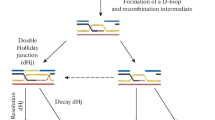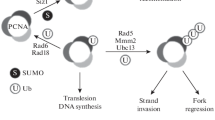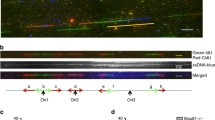Summary
The formation and repair of double-strand breaks induced in DNA by MMS was studied in haploid wild type and MMS-sensitive rad6 mutant strains of Saccharomyces cerevisiae with the use of the neutral and alkaline sucrose sedimentation technique. A similar decrease in average molecular weight of double-stranded DNA from 5–6x108 to 1–0.7x108 daltons was observed following treatment with 0.5% MMS in wild type and mutant strains. Incubation of cells after MMS treatment in a fresh drug-free growing medium resulted in repair of double-strand breaks in the wild type strain, but only in the exponential phase of growth. No repair of double-strand breaks was found when cells of the wild type strain were synchronized in G-1 phase by treatment with α factor, although DNA single-strand breaks were still efficiently repaired. Mutant rad6 which has a very low ability to repair MMS-induced single-strand breaks, did not repair double-strand breaks regardless of the phase of growth.
These results suggest that (1) repair of double-strand breaks requires the ability for single-strand breaks repair, (2) rejoining of double-strand breaks requires the availability of two homologous DNA molecules, this strongly supports the recombinational model of DNA repair.
Similar content being viewed by others
References
Blamire, J., Cryer, D.R., Finkelstein, D.B., Marmur, J.: Sedimentation properties of yeast nuclear and mitochondrial DNA. J. molec. Biol. 67, 11–24 (1972)
Bücking-Throm, E., Duntze, W., Hartwell, L.H., Manney, T.R.: Reversible arrest of haploid yeast cells at the initiation of DNA synthesis by a diffusible sex factor. Exp. Cell Res. 76, 99–110 (1973)
Coyle, M.B., Strauss, B.S.: Characteristics of DNA synthesized by methyl methanesulphonate treated HEp-2 cells. Chem.-Biol. Interactions 1, 89–98 (1969–1970)
Duntze, W., Stötzler, D., Bücking-Throm, E., Kalbitzer, S.: Purification and partial characterisation of α factor, a mating-type specific inhibitor of cell reproduction from Saccharomyces cerevisiae. Europ. J. Biochem. 35, 357–365 (1973)
Forte, M.A., Fangman, W.L.: Naturally occuring cross-links in yeast chromosomal DNA. Cell 8, 425–431 (1976)
Fox, B.W., Fox, M.: Sensitivity of the newly synthesized and temphlate DNA of Lymphoma cells to damage by methyl methane-sulphonate and the nature of associated repair processes. Mutation Res. 8, 629–638 (1969)
Freifelder, D.: Molecular weight of coliphages and coliphage DNA. J. molec. Biol. 54, 567–577 (1970)
Galzy, P., Slonimski, P.P.: Variations physiologiques de la levure en course de la croissance sur l'acide lactique ou sur glucose comme seule source de carbone. C.R. Acad. Sci. (Paris) 245, 2423–2429 (1957)
Hatzfeld, J.: DNA labeling and its assay in yeast. Biochim. biophys. Acta (Amst.) 299, 34–42 (1973)
Ho, K.S.Y.: Induction of DNA double-strand breaks by X-rays in a radiosensitive strain of the yeast Saccharomyces cerevisiae. Mutation Res. 30, 327–334 (1975)
Howard-Flanders, P., Boyce, R.P.: DNA repair and genetic recombination studies on mutants of Escherichia coli defective in these processes. Radiat. Res., Suppl. 6, 156–184 (1966)
Jachymczyk, W.J., Chlebowicz, E., Swietlinska, Z., Żuk, J.: Alkaline sucrose sedimentation studies of MMS-induced DNA single-strand breakage and rejoining in the wild type and in UV-sensitive mutants of Saccharomyces cerevisiae. Mutation Res. 43, 1–10 (1977)
Krasin, F., Hutchinson, F.: Repair of DNA double-strand breaks in Escherichia coli, which requires recA function and the presence of a duplicate genome. J. molec. Biol. 116, 81–98 (1977)
Lang, D.: Molecular weight of coliphages and coliphage DNA. J. molec. Biol. 54, 557–565 (1970)
Laval, J.: Two enzymes are required for strand incision in repair of alkylated DNA. Nature (Lond.) 269, 829–832 (1977)
Loppes, R.: Damage induced by methyl methanesulphonate MMS in Chlamydomonas reinhardi. Z. Vererbungsl. 98, 193–202 (1966)
Luchnik, A.N., Glaser, V.M., Shestakov, S.V.: Repair of DNA double-strand breaks requires two homologous DNA duplexes. Molec. Biol. Reports 3, 437–442 (1977)
Petes, T.D., Fangman, W.L.: Sedimentation properties of yeast chromosomal DNA. Proc. nat. Acad. Sci. (Wash.) 69, 1188–1191 (1972)
Prakash, L.: Lack of chemically induced mutation in repair-deficient mutants of yeast. Genetics 78, 1101–1118 (1974)
Reiter, H., Strauss, B.: Repair of damage induced by a monofunctional alkylating agent in a transformable ultraviolet sensitive strain of Bacillus subtilis. J. molec. Biol. 14, 179–194 (1965)
Reiter, H.B., Strauss, B., Robbins, M., Marone, R.: Nature of the repair of methyl methanesulphonate induced damage in Bacillus subtilis. J. Bact. 93, 1056–1062 (1967)
Resnick, M.A.: The repair of double-strand breaks in DNA: a model involving recombination. J. theoret. Biol. 59, 97–106 (1976)
Resnick, M.A., Martin, P.: The repair of double-strand breaks in the nuclear DNA of Saccharomyces cerevisiae and its genetic control. Molec. gen. Genet. 143, 119–129 (1976)
Strauss, B.S., Wahl, R.: The presence of breaks in the deoxyribonucleic acid of Bacillus subtilis treated in vivo with the alkylating agent methyl methanesulphonate. Biochim. biophys. Acta (Amst.) 80, 116–126 (1964)
Swietlińska, Z., Zaborowska, D., Żuk, J.: Survival and liquid holding recovery in UV-sensitive strains of Saccharomyces cerevisiae after treatment wicht chemical mutagens and radiations. Acta microbiol. pol. 25, 295–305 (1976)
Thomas, C.A., Abelson, J.: The isolation and characterisation of DNA from bacteriophage. In: Procedures in nucleic acid research (G.L. Cantoni and D.R. Davies, eds.), Vol. 1–2. New York: 1966–1967
Throm, E., Duntze, W.: Mating-type-dependent inhibition of deoxyribonucleic acid synthesis in Saccharomyces cerevisiae. J. Bact. 104, 1388–1390 (1970)
Van den Berg, H.W.: Alkaline sucrose gradient sedimentation studies of DNA from HeLaS3 cells exposed to methyl methanesulphonate or methylazoxymethanol acetate. Biochim. biophys. Acta (Amst.) 353, 215–226 (1974)
Walker, J.G., Sridhar, R.: The formation and repair of single-strand breaks in DNA of cultured mammalian cells treated with UV-light, methylating agents or 4-nitroquinoline-1-oxide. Chem.-Biol. Interactions 12, 229–239 (1976)
Williamson, D.H.: The timing of deoxyribonucleic acid synthesis in the cell cycle of Saccharomyces cerevisiae. J. Cell Biol. 25, 517–528 (1965)
Zimmerman, F.K.: Sensitivity to methyl methanesulphonate and nitrous acid of ultraviolet light-sensitive mutants in Saccharomyces cerevisiae. Molec. gen. Genet. 102, 247–256 (1968)
Author information
Authors and Affiliations
Additional information
Communicated by F. Kaudewitz
Rights and permissions
About this article
Cite this article
Chlebowicz, E., Jachymczyk, W.J. Repair of MMS-induced DNA double-strand breaks in haploid cells of Saccharomyces cerevisiae, which requires the presence of a duplicate genome. Molec. Gen. Genet. 167, 279–286 (1979). https://doi.org/10.1007/BF00267420
Received:
Issue Date:
DOI: https://doi.org/10.1007/BF00267420




